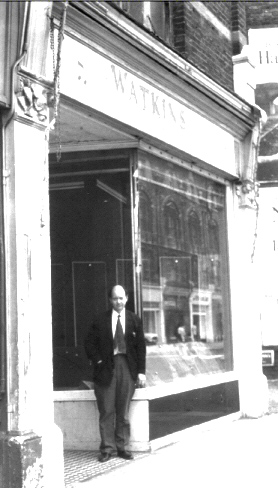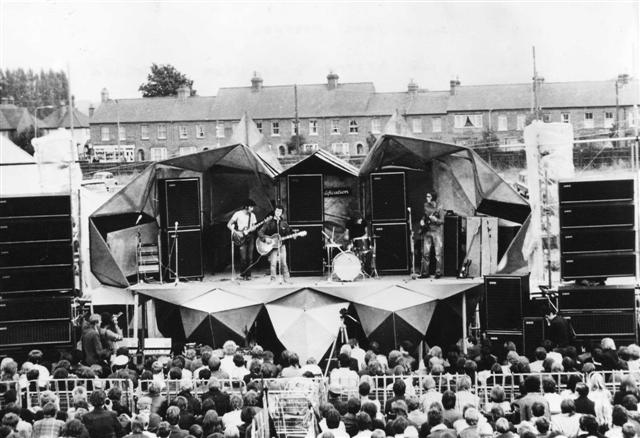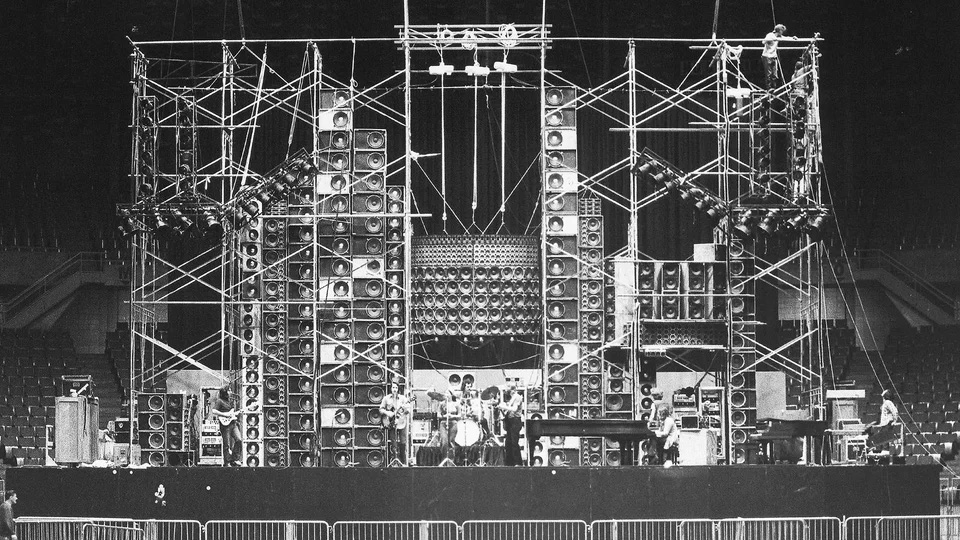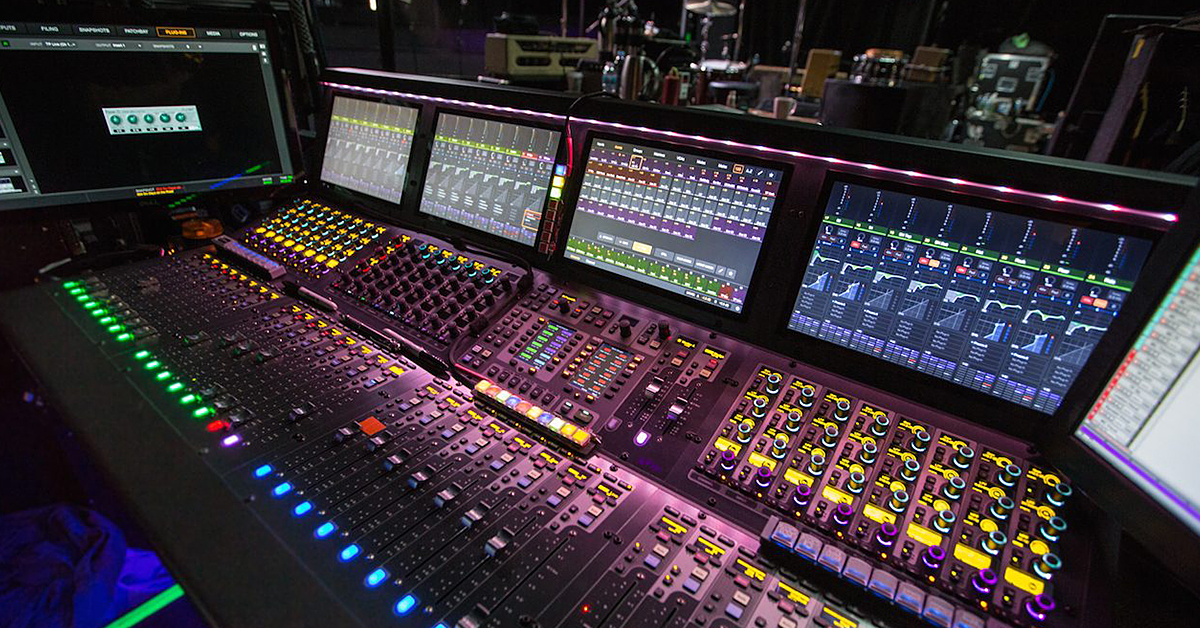Article 42: Everything louder than everything else
Ian Gillan’s famous words from Deep Purple’s Made in Japan album and which went on to become the title of Motorhead’s third live album, were said as a joke but they are closer to the truth than most people realise. The development of the rock Public Address system (P.A.) happened so quickly that in the space of less than fifteen years, it went from being a way to amplify the vocals, to a monster that could be heard several miles away. The modern P.A. system is a complex instrument in its own right which needs skilled operators. They play a very important part in the show and are arguably someone as valuable to the band as any band member themselves. Now, the live mixing console is computer based and I admit, I am lost on them. It’s a different world in most respects to when I mixed bands in the 1980s and that in turn was a different world to when the Beatles played to 56,000 people at Shea Stadium in 1965. They used four Altec 1570 amplifiers, giving a grand total of 700 Watts (700W). Think about that the next time you are at Tokyo Dome, Wembley or and other stadium but in the meantime, let’s give a big round of applause to and learn a bit about the man who started it all, Charlie Watkins.
なんでもかんでも大音量
イアン・ギランがディープ・パープルのアルバム『メイド・イン・ジャパン』の中で語った有名な言葉であり、その後モーターヘッドの3枚目のライブアルバムのタイトルにもなったこの言葉は、彼が冗談で言ったものだが、多くの人が思っている以上に真実に近い。ロックのPA(Public Address System)の開発は非常に早く、15年足らずの間に、ボーカルを増幅するためだけのものから、数マイル先まで聞こえる怪物にまで発展してしまった。現代のPAシステムは、それ自体が複雑な機器であり、熟練したオペレーターが必要である。彼らはショーにおいて非常に重要な役割を担っており、バンドメンバー自身と同じくらいバンドにとって価値のある人物であることは間違いない。今、ライブのミキシングコンソールはコンピュータベースで、正直、操作に迷ってしまう。1980年代に私がバンドをミックスしていた頃とは、ほとんどの点で世界が違うし、1965年にビートルズがシアスタジアムで56,000人を前に演奏した時とはまた違う世界なのだ。彼らはアルテック1570アンプを4台使用し、合計700Wの大出力だった。今度、東京ドームやウェンブリーなどのスタジアムに行く時は、そのことを考えてみてほしい。その間に、すべてを始めた男、チャーリー・ワトキンスに 盛大な拍手を送りつつ 、彼について少し学んでみよう。
Back in the 40s, amplification was only used for singers (if at all) and even then, it was through a small in-house P.A. system. The musicians backing the singer used their own dynamics to aid the singer’s performance but the advent of Rock and Roll and the electric guitar changed everything. By the early 1960’s, electric guitars, basses and pianos, along with the early keyboards such as the Clavioline, had become the fashionable instruments for popular music, all of which were independently amplified on stage. Then in 1964, Vox produced their AC100 Super Deluxe guitar cabinets with four speakers and two horns. They went to John Lennon and George Harrison who used them on The Beatles' first American tour but it didn’t make much difference; they still couldn’t be heard above the screaming. A year later, Pete Townsend and John Entwistle from The Who worked with Jim Marshall to develop the Marshall Stack, a 100W amplifier powering an eight-speaker cabinet which quite simply, was deafening. All of this development of course meant that the vocals also had to be somehow amplified.
40年代には、増幅器は歌手にしか使われず(使われるとしても)、それも小さな場内P.A.システムを通してだった。バックのミュージシャンがそれぞれの楽器のダイナミクスでシンガーのパフォーマンスを助けていたのだが、ロックンロールとエレクトリック・ギターの出現は、すべてを変えてしまった。1960年代初めには、エレクトリックギター、ベース、ピアノ、そしてクラビオリンなどの初期のキーボードがポピュラー音楽の流行楽器となり、ステージではこれらすべてが独立して増幅されるようになった。そして1964年、Voxは4つのスピーカーと2つのホーンを搭載したAC100 Super Deluxeギターキャビネットを製造した。それらはジョン・レノンとジョージ・ハリスンの元に届き、ビートルズの最初のアメリカ・ツアーで使われたが、これまでとあまり大きな違いはなかった。女の子たちの叫び声で楽器の音は聞こえなかったのだ。その1年後、ザ・フーのピート・タウンゼントとジョン・エントウィッスルはジム・マーシャルと協力して、8つのスピーカー・キャビネットを駆動する100Wのアンプ、マーシャル・スタックを開発した。もちろん、このような開発は、ボーカルも何とかして増幅させなければならないことを意味した。
The very early P.A.s were usually two columns of 4 x 12” speakers driven by a 100W amp. This was enough to hear the vocals over the 30W Vox AC30 amplifiers that the musicians favoured but the speakers were poor quality and quite often the microphone used was the cheapest the singer could find in the shop due to the band’s budget. This combination gave a very mid-range sound with no bass, very little treble and often produced feedback but the bands struggled through with it as there was no alternative. With bass, guitars and keyboards all now being highly audible, the vocals strained to be heard above the instruments so a new type of P.A. was badly needed but the problem was, valve technology. It tended to distort vocals at high volume and two amplifiers could not be linked together as it caused feedback. Then in 1966, RCA developed the solid-state guitar amplifier using transistors instead of valves. They were lighter and more reliable with a very clean sound but the transistors didn’t have the warm sound of valves so guitarists didn’t like them. Amazingly, only one man realized that the clearer sound was ideal for P.A.s and vocals, the aforementioned Charlie Watkins.
初期のPAは、4×12インチのスピーカーを2列に並べ、100Wのアンプで駆動するのが一般的だった。ミュージシャンが好んで使っていた30WのVox AC30アンプでボーカルを聴くには十分だったが、スピーカーは質が悪く、マイクもバンドの予算の関係で歌手がショップで見つけた一番安いものを使うことがよくあった。この組み合わせは、低音がなく、高音もほとんどない中音域の音で、しばしばハウリングを起こすが、代替手段がないため、バンドはこの組み合わせで苦労していた。ベース、ギター、キーボードの音がよく聞こえるようになり、ボーカルが楽器の上に聞こえるようになるためには、新しいタイプのPAが必要になったのだが、問題はバルブ(真空管)技術だった。大音量ではボーカルを歪ませてしまう傾向があり、ハウリングを起こすため2台のアンプを連結して使用することができなかった。そして1966年、RCA社はバルブの代わりにトランジスタを使用したソリッドステート・ギターアンプを開発した。しかし、トランジスタはバルブのような暖かみのある音ではないので、ギタリストには不評だった。驚いたことに、このクリアなサウンドがPAやボーカルに最適だと気づいたのは、前述のチャーリー・ワトキンスただ一人だったのである。

Photo 01 Charlie Watkins outside his first shop at 26 Balham High Street, South London.
Photo 01 南ロンドン、バルハム・ハイ・ストリート26番地にある最初の店の前にいるチャーリー・ワトキンス。
Born in 1923, Charlie was in the Merchant Navy during WWII which is where he learnt to play the accordion. In 1945, after leaving the army, Charlie became a professional accordion player and then in 1949, with his brother, Reg, opened a small record shop in South London. Their business flourished quickly and relocating a few miles away to Balham in 1951 where they also started to deal in musical instruments, most notably, guitars and, of course, accordions. It wasn’t much later, aided by the Skiffle craze in the UK in the mid-fifties, that Charlie realized there would be a market for an acoustic guitar amplifier and developed one: the Westminster Amplifier.
1923年に生まれたチャーリーは、第二次世界大戦中、商船隊に所属しており、そこでアコーディオンを習った。1945年、軍を退役したチャーリーはプロのアコーディオン奏者となり、1949年には弟のレグと一緒にサウスロンドンに小さなレコード店を開いた。彼らのビジネスは急速に発展し、1951年には数マイル離れたバルハムに移転し、ギターやアコーディオンをはじめとする楽器の取り扱いを開始した。その後、50年代半ばにイギリスで起こったスキッフル・ブームも手伝って、チャーリーはアコースティック・ギター・アンプの市場があることに気づき、開発した。それが、ウエストミンスター・アンプである。
The Westminster Amplifier was a success and in high demand and by 1957, Reg had opened a factory making Watkins guitars and amplifiers. The company was called Watkins Electronic Music (WEM) and their undoubted biggest success was a guitar effect, the Watkins Copycat Echo Unit* which along with the Vox AC30 and the Fender Strat, pretty much defined the sound of the 60’s in popular music. Indeed, they are still regarded as the standard by which all other echo units are judged and thousands are still used every night by bands around the world.
ウエストミンスター・アンプは成功し、需要が高まり、1957年にはレグはワトキンスギターとアンプを製造する工場を開設していた。この会社はワトキンス・エレクトロニック・ミュージック(WEM)と呼ばれ、間違いなく最大の成功は、Vox AC30やFender Stratとともに60年代のポピュラー音楽のサウンドを決定づけたギターエフェクト、「ワトキンス・コピーキャット・エコー・ユニット*」だった。実際、他のすべてのエコー装置が評価される基準として、これは今でも評価されていて、現在でも、世界中のバンドで数千台のエコー装置が使われている。
Anyway, getting back to the valve and transistor amplifier comparison, it was Charlie who saw the potential of the transistor amplifier and developed the world’s first P.A. as we know it today by slaving amplifiers together and linking them to multiple speaker cabinets (called ‘columns’ due to there being 4, 12” speakers arranged in a column). Charlie also separated the mixer from the amplifier which meant that the sound could now be controlled from the front with the audience rather than at the side of the stage. That first ‘out-front’ mixer had five inputs and was called the Audiomaster. In 1967, on August 11th to be precise, Charlie unveiled the world’s first 1000W P.A. system at the Windsor Jazz & Blues festival in the UK but it was not without its problems, breaking down on several occasions, causing delays in the schedule. There were also complaints from the local residents as well so the volume had to be turned down halfway through the festival much to the disgruntlement of the bands and audience. Despite these setbacks though, it was hailed a revolution in sound amplification and soon every band across the UK was using a WEM (Watkins Electronic Music) system. A modification to the five-channel desk meant that two or more desks could be linked together and it soon became common practice to run all the instruments as well as the vocals through the P.A. to give an overall better balance of sound.
さて、バルブアンプとトランジスタアンプの比較に話を戻すと、トランジスタアンプの可能性を見出したのはチャーリーで、アンプをスレーブ接続し、複数のスピーカーキャビネット(12インチのスピーカーが4本並んでいることから「カラム」と呼ばれる)に繋いで、現在のような世界初のPAを開発したのである。また、ミキサーとアンプを分離したことで、ステージの脇からではなく、観客の目の前で音をコントロールできるようになった。その最初の「アウトフロント」ミキサーは5つの入力を持ち、「オーディオマスター」と呼ばれていた。1967年、正確にはその年の8月11日、チャーリーはイギリスのウィンザー・ジャズ&ブルース・フェスティバルで世界初の1000WのPAシステムを発表したが、問題がなかったわけではなく、何度か故障してスケジュールに遅れが生じた。また、地元住民からの苦情もあり、フェスティバルの途中で音量を下げざるを得なくなり、バンドや観客の不満が爆発した。しかし、このような挫折にもかかわらず、サウンドアンプにおける革命と称され、すぐにイギリス中のすべてのバンドがWEM(ワトキンス・エレクトロニック・ミュージック)システムを使用するようになった。5チャンネルのデスクを改造して2台以上のデスクを連結し、ボーカルだけでなくすべての楽器をP.A.に通して全体の音のバランスをとることがすぐに一般的になったのである。

Photo 02 Peter Green’s Fleetwood Mac onstage flanked by Charlie’s 1000W P.A. at the 1967 Windsor Jazz & Blues festival.
Photo 02 1967年のウィンザー・ジャズ&ブルース・フェスティバルで、チャーリーの1000W P.A.に挟まれてステージに立つピーター・グリーンのフリートウッド・マック。
The next development in the P.A. came from the USA in the early 1970’s and that was the use of speaker cabinets designed for cinemas instead of the WEM columns. Cinema sound was a lot more technical than P.A. sound at that point and the cinemas used something called a horn-loaded bin which is to say it has a woofer (speaker) for the lower frequencies and a tweeter (horn) for the high frequencies in the same cabinet. The two parts were separated by a crossover which stopped the bass sound going into the horn and treble sound going into the speaker. The human ear is much more sensitive to horn frequencies and the position or angle of the cabinet could be used to throw the sound in a particular direction helping to give the same sound balance in all seats of the venue. Rather quickly, the bin and horn system phased out the column P.A.s but with this added volume came another problem: the bands could not hear themselves play and so a monitor system was introduced. Often called the foldback, it is actually a mini-P.A. system in itself. The microphones are all plugged into a stage box (also known as a splitter box) which simultaneously sends the signal to the out-front desk for the sound engineer to mix for the audience and another smaller monitor desk at the side of the stage that is used to balance the sound onstage for the band. It took great skill and a good ear to avoid the original 1960’s problem of feedback and also to provide the clarity that the audience and the bands demanded, as two engineers vied for a good mix from the same show.
P.A.の次の開発は、1970年代初頭にアメリカからもたらされたもので、それはWEMカラムの代わりに映画館用に設計されたスピーカーキャビネットを使用することであった。映画館の音響は、その時点ではPAよりもずっと技術的で、映画館ではホーンロード・ビンというものを使っていた。つまり、低域用のウーファー(スピーカー)と高域用のトゥイーター(ホーン)を同じキャビネットに搭載していたのである。この2つのパーツは、ホーンに入る低音とスピーカーに入る高音を止めるクロスオーバーで分離されていた。人間の耳はホーン周波数に敏感で、キャビネットの位置や角度によって音を特定の方向に投射することで、会場のどの席でも同じ音のバランスが得られるのだ。ビンとホーンシステムによって、コラム型PAはあっという間に姿を消したが、この音量アップにはもう一つ問題があった。バンドが自分たちの演奏を聴くことができなかったのだ。そのため、モニターシステムが導入されたのである。これはフォールドバックと呼ばれることが多いが、実はこれ自体がミニP.A.システムである。マイクはすべてステージボックス(スプリッターボックスとも呼ばれる)に接続され、サウンドエンジニアが観客用にミキシングするアウトフロントデスクと、バンドのステージ上のサウンドバランスを整えるためにステージ脇にある別の小型モニターデスクに同時に信号が送られるようになっている。1960年代オリジナルのハウリングという問題を回避し、さらに観客やバンドが求めるクリアな音を提供するためには、2人のエンジニアが同じショーの良いミックスを競い合うように、素晴らしい技術と優れた耳を持つことが必要だったのだ。
Size escalated rapidly and during the 1970’s, a big P.A. of between 20,000W and 40,000W became a boasting point of the bigger rock bands such as Deep Purple and Led Zeppelin. On August 1st 1981, the biggest ever P.A. was assembled by the Audiolease P.A. company in the UK. The venue was Port Vale football stadium where twenty-two P.A. staff spent two days putting together a system for the Heavy Metal Holocaust festival headlined by Motorhead. The P.A was not only either side of the stage, it ran the full width underneath the bands, blasting out 120,000W and entering the Guinness Book of World Records. It had taken less than fourteen years to go from Charlie’s 1000W milestone to an ear-bleeding wall of sound.
サイズもどんどん大きくなり、1970年代には20,000Wから40,000Wの大型PAがディープ・パープルやレッド・ツェッペリンなどの大物ロックバンドの自慢の的になった。1981年8月1日、イギリスのオーディオリースP.A.社によって、史上最大のP.A.が組み立てられた。会場はポートベイル・フットボールスタジアムで、モーターヘッドがヘッドライナーを務める「ヘビーメタル・ホロコースト」フェスティバルのために、22名のPAスタッフが2日間かけてシステムを構築した。P.A.はステージの両脇だけでなく、バンドステージの下の幅いっぱいに設置され、12万Wの大音量でギネスブックに登録されている。チャーリー氏の1000Wというマイルストーンから、耳をつんざくような音の壁になるまで、14年もかからなかったのだ。
The commercial success of Kayleigh led to a hugely successful album that hit No. 1 on 29th June 1985 and was top 10 in many other European markets; it even cracked the US Billboard chart peaking at No. 47. Misplaced Childhood brought Progressive Rock up to date and made it more accessible to average record buyer who preferred singles. In the UK, many other bands existing Prog bands such as Twelfth Night, IQ and Pallas started to draw greater audiences and new bands and sub-genres (Prog Metal, Nu Prog, etc) started to appear. After a five-year lull, Prog Rock was back.
「Kayleigh」の商業的成功は、1985年6月29日に1位を獲得し、他の多くのヨーロッパ市場でもトップ10に入るなど、大成功を収めた。全米ビルボードチャートでは、47位を記録した。『Misplaced Childhood』は、プログレッシブ・ロックを最新のものにし、シングルを好む一般のレコード購入者がよりアクセスしやすいものにした。イギリスでは、トゥウェルフス・ナイト、アイキュー、パラスといった既存のプログレバンドが多くの観客を集め始め、新しいバンドやサブジャンル(プログレ・メタル、ヌー・プログレなど)が登場し始めた。5年ぶりにプログレが復活したのである。

Photo 03 The Grateful Dead’s ‘Wall of Sound’ was designed for their US tour in 1974. It was comprised of 604 speakers and 92 amplifiers generating a total of 26,400W.
Photo 03 グレイトフル・デッドの「ウォール・オブ・サウンド」は、1974年のアメリカ・ツアーのためにデザインされた。604個のスピーカーと92個のアンプで構成され、合計26,400Wを発生させる。
These days, computers run everything and P.A.s are no exception. Sound systems can be fine tuned with the aid of a tablet as the engineer walks around the venue using digital compressors, limiters, 31 band graphics and a deluge of other effects to enhance the sound. Not all venues are kind to sound however and no technology yet invented can cancel out the horrible reverberations that bounce around places like Tokyo Dome but the sound engineer lives in hope as he twiddles knobs and pushes faders, countering feedback, echoes and bad acoustics to give everyone in the audience a CD quality mix. These guys are the unsung heroes of a show so the next time you go to a gig and the sound is good, give the man behind the desk a thumbs up to say thanks for a job well done because without him, you wouldn’t hear a thing.
最近では、あらゆるものがコンピュータで処理されるようになり、P.A.も例外ではない。デジタルコンプレッサーやリミッター、31バンドのグラフィックなど、大量のエフェクトを駆使してサウンドシステムを微調整しながら、エンジニアが会場内を歩き回ることも可能だ。しかし、東京ドームのように残響を打ち消す技術はまだ発明されていないが、音響エンジニアは希望を持ってノブを回し、フェーダーを押して、フィードバック、エコー、音響の悪さを打ち消し、観客全員にCD品質のミックスを提供する。この人たちはショーの縁の下の力持ちだ。今度ライブに行った時、音が良かったら、机の後ろにいる男性に親指を立てて、よくやったねと感謝してください。なぜなら、彼がいなければ何も聞こえないのだから。
As for Charlie Watkins, well, he lived his life and developed his P.A.s but closed his WEM P.A. company when in 1974, after it was revealed to him that there were now possibly dangerous levels of sound at Rock concerts. He went back to playing the accordion but his love of electronics and sound never left him and he was the man who many years later, developed the accordion MIDI interface. A long time after I moved out of South London, I discovered that I lived just a couple of minutes’ walk from his house. I probably saw him in a shop, exchanged pleasantries on a sunny Sunday morning or stood next to him in a local pub and didn’t recognize him. Never one to boast of his achievements, he was awarded the Audio Pro International Lifetime Achievement Award for his contribution to loudspeakers and PA for outdoor Rock events. Charlie died at his home, in Balham, on 28th October, 2014.
チャーリー・ワトキンスは、自分の人生を誇らしく生き、P.A.を開発したが、1974年、ロックコンサートで危険なレベルの音響が発生していることが明らかになり、WEM P.A.の会社を閉めた。彼はアコーディオンの演奏に戻ったが、エレクトロニクスとサウンドへの愛情は尽きることがなく、何年も経ってからアコーディオンのMIDIインターフェースを開発した人物でもある。サウス・ロンドンから引っ越し、ずいぶん経ってから、私は彼の家から歩いて2、3分のところに住んでいることが分かった。恐らく、お店で見かけていたか、晴れた日曜日の朝に挨拶を交わしていたか、あるいは地元のパブで隣に立っていたのかもしれないが、分からなかったのだろう。彼はその功績を誇示することなどなかったのだが、ロックイベントの野外用スピーカーとPAへの貢献が認められ、「Audio Pro International Lifetime Achievement Award」を贈られている。チャーリーは、2014年10月28日、バルハムの自宅で亡くなった。

42-04 The principle is the same, i.e. instruments in, balanced sound out but I’ll be darned if I know what all that does now.
Photo 04 原理は同じで、各楽器が各チャンネルに入り、バランスの取れた音が出るというものだが、それが何をするものなのか、今となってはよく解らない。
*The first Watkins Copicat Echo Unit was sold to a man named Joe Moretti. He was the guitarist in Johnny Kidd & The Pirates and he was the first person known to have used it on a recording. That was Shakin’ All Over and it gave them their first UK No.1 in August, 1960.
*最初のワトキンス・コピーキャット・エコー・ユニットは、ジョー・モレッティという人物に販売された。彼はジョニー・キッド&ザ・パイレーツのギタリストであり、レコーディングで使用した最初の人物として知られている。使用された曲は「Shakin' All Over」で、1960年8月、彼らにとって初の全英1位をもたらした。
Copyright © 2023 Upp-tone music Co., Ltd. All Rights Reserved.